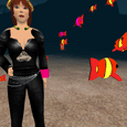
« PREVIOUS ENTRY
Mirror, mirror, on the wall
NEXT ENTRY »
Welcome to the C list

Artificial-life sims have always been lots of fun, except for one problem: For decades, the “life forms” have only existed on the computer screen, so they’ve never seemed very real. This all started to change with the Internet and video games, where the action of real life itself takes place — bien sur — on the screen. When you’re an avatar in a virtual world, the line between who’s “real” and who’s “artificial” is much easier to blur.
A brilliant example of this is the work of Surina Skallagrimson, a resident of Second Life, the increasingly-popular 3D immersive game-world. Second Life has a simple scripting language that allows users to create their own in-game stuff; recently, Skallagrimson decided to create a school of fish. She wrote a script to govern the behavior of an individual fish, then made hundreds of copies with slightly different attributes: Some could swim fast, others could see farther, and so on. Then she turned the fish loose in Second Life’s ocean to see what they’d do. Most of ‘em just wandered around aimlessly, so she killed them off; the few that seemed to behave more purposefully, she kept.
She did this a few hundred times and, in essence, created her own little evolutionary hothouse — such that she now has a school of fish that behaves very, uh, fishlike. (Fishy?) Anyway, Wagner James Au — the writer who pens a brilliant blog reporting on the goings-on inside the world of Second Life — recently met up with her at the bottom of the ocean, where she showed off her school. As Au notes:
The gold standard for any creator of artificial life is unplanned emergent behavior, and Surina has noticed at least a couple instances of these. For one, with enough fish in the school, they begin to move in circles. “[T]hey tend to form a line. And if the front moves around so it ‘sees’ the back of the line, they circle.” With the addition of food, she’s also noticed that “the weaker ones tend to lead the shoal. They are the ones most in need of food. The ones most in need of food will tend to break away from the shoal. This causes the rest of the shoal to follow, so you end up with the weakest near the front, heading for food.”
(Thanks to W. James Au for this one!)
I'm Clive Thompson, the author of Smarter Than You Think: How Technology is Changing Our Minds for the Better (Penguin Press). You can order the book now at Amazon, Barnes and Noble, Powells, Indiebound, or through your local bookstore! I'm also a contributing writer for the New York Times Magazine and a columnist for Wired magazine. Email is here or ping me via the antiquated form of AOL IM (pomeranian99).

ECHO
Erik Weissengruber
Vespaboy
Terri Senft
Tom Igoe
El Rey Del Art
Morgan Noel
Maura Johnston
Cori Eckert
Heather Gold
Andrew Hearst
Chris Allbritton
Bret Dawson
Michele Tepper
Sharyn November
Gail Jaitin
Barnaby Marshall
Frankly, I'd Rather Not
The Shifted Librarian
Ryan Bigge
Nick Denton
Howard Sherman's Nuggets
Serial Deviant
Ellen McDermott
Jeff Liu
Marc Kelsey
Chris Shieh
Iron Monkey
Diversions
Rob Toole
Donut Rock City
Ross Judson
Idle Words
J-Walk Blog
The Antic Muse
Tribblescape
Little Things
Jeff Heer
Abstract Dynamics
Snark Market
Plastic Bag
Sensory Impact
Incoming Signals
MemeFirst
MemoryCard
Majikthise
Ludonauts
Boing Boing
Slashdot
Atrios
Smart Mobs
Plastic
Ludology.org
The Feature
Gizmodo
game girl
Mindjack
Techdirt Wireless News
Corante Gaming blog
Corante Social Software blog
ECHO
SciTech Daily
Arts and Letters Daily
Textually.org
BlogPulse
Robots.net
Alan Reiter's Wireless Data Weblog
Brad DeLong
Viral Marketing Blog
Gameblogs
Slashdot Games